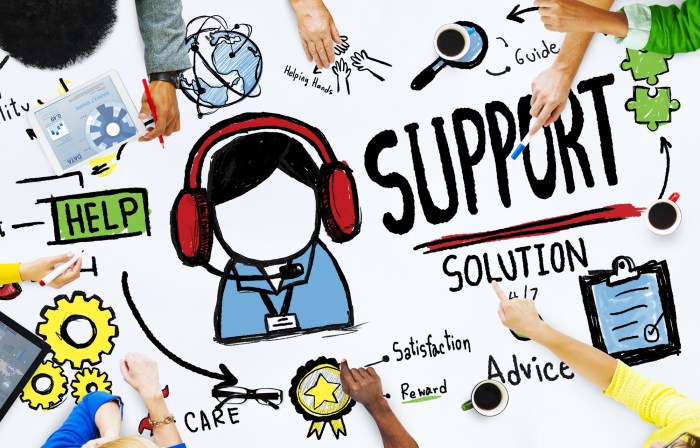Developing Customer Support Solutions is the key to unlocking business success in today’s competitive market. From understanding the importance to implementing effective strategies, this topic delves into the intricate world of customer support solutions.
Get ready to explore the realm of customer support like never before as we uncover the secrets behind creating exceptional support experiences for your customers.
Understanding Customer Support Solutions

In today’s competitive business landscape, developing effective customer support solutions is crucial for ensuring customer satisfaction and loyalty. By providing timely and efficient support to customers, businesses can enhance their reputation, increase customer retention, and ultimately drive growth.
Examples of Successful Customer Support Solutions
- Amazon’s 24/7 customer service hotline and live chat support
- Zappos’ legendary customer service with free returns and exchanges
- Apple’s Genius Bar for in-person technical support
Key Elements of Comprehensive Customer Support Solutions
- Multiple communication channels (phone, email, live chat, social media)
- Knowledgeable and well-trained support staff
- Quick response times and resolution of issues
- Personalized customer interactions
Impact of Poor Customer Support Solutions on Businesses
Customer support solutions that are inadequate or ineffective can have detrimental effects on businesses, including:
- Loss of customer trust and loyalty
- Negative word-of-mouth and reputation damage
- Decreased customer retention and repeat business
- Missed opportunities for upselling and cross-selling
Designing Customer Support Systems

In designing customer support systems, companies need to consider the needs and preferences of their customers to ensure efficient and effective solutions. This involves creating a framework that allows for seamless communication and problem-solving between the customer and the support team.
Types of Customer Support Systems
- Phone Support: This traditional method involves customers calling a support line to speak with a representative for assistance.
- Email Support: Customers can send detailed inquiries or issues via email, with support agents responding accordingly.
- Live Chat Support: Real-time messaging allows for instant communication between customers and support staff for quick problem resolution.
- Self-Service Support: Online resources such as FAQs, knowledge bases, and tutorials enable customers to find solutions independently.
Comparison of Traditional vs. Modern Customer Support Systems
- Traditional: Relies heavily on human interaction, which can lead to longer wait times and potential miscommunication.
- Modern Automated Systems: Utilize technology like chatbots and AI to provide instant responses and personalized support, improving efficiency.
Role of Technology in Enhancing Customer Support Solutions
Technology plays a crucial role in enhancing customer support solutions by streamlining processes, improving response times, and increasing customer satisfaction. Automation tools can help gather data, analyze customer inquiries, and provide tailored solutions, ultimately leading to a more seamless support experience.
Implementing Customer Support Strategies: Developing Customer Support Solutions
Implementing customer support strategies effectively is crucial for maintaining customer satisfaction and loyalty. By following best practices for training customer support teams and personalizing support based on individual needs, businesses can improve the overall customer experience. Additionally, implementing feedback loops allows for continuous improvement in customer support strategies.
Training Customer Support Teams
Training customer support teams is essential for ensuring they have the knowledge and skills to assist customers effectively. Best practices for training include providing comprehensive product knowledge, teaching effective communication techniques, and offering ongoing training to keep teams updated on new developments. By investing in training, businesses can empower their support teams to provide exceptional service.
Personalizing Customer Support
Personalizing customer support involves understanding each customer’s unique needs and preferences. This can be achieved by collecting data on customer interactions and using it to tailor support experiences. By personalizing support, businesses can create more meaningful connections with customers and enhance overall satisfaction.
Importance of Feedback Loops
Feedback loops are essential for gathering insights into the effectiveness of customer support strategies. By collecting feedback from customers and analyzing it regularly, businesses can identify areas for improvement and make necessary adjustments. Implementing feedback loops ensures that customer support strategies remain relevant and responsive to changing customer needs.
Utilizing Data for Customer Support
In today’s digital age, data plays a crucial role in developing effective customer support solutions. By leveraging data analytics, businesses can gain valuable insights into customer behavior, preferences, and pain points, allowing them to tailor their support strategies for maximum impact.
Role of Data Analytics in Customer Support
Data analytics helps businesses track and analyze customer interactions across various touchpoints, such as phone calls, emails, chats, and social media. By examining this data, companies can identify trends, patterns, and recurring issues, enabling them to proactively address customer needs and improve overall satisfaction.
- Identifying customer trends and patterns
- Pinpointing areas for improvement in support processes
- Personalizing customer interactions for a tailored experience
Enhancing Customer Support Experiences with Data Insights
Data insights can be used to enhance customer support experiences by predicting customer needs, resolving issues more efficiently, and offering proactive solutions. By analyzing data in real-time, businesses can anticipate customer concerns and provide timely assistance, ultimately leading to higher customer satisfaction and loyalty.
- Implementing predictive analytics to anticipate customer needs
- Leveraging data to offer personalized and proactive support
- Improving response times and resolution rates based on data analysis
Key Performance Indicators (KPIs) for Measuring Customer Support Effectiveness
Measuring customer support effectiveness is essential for monitoring performance and identifying areas for improvement. Key performance indicators (KPIs) help businesses gauge the success of their support efforts and make data-driven decisions to enhance the overall customer experience.
Examples of KPIs:
- First response time
- Resolution time
- Customer satisfaction scores
- Net Promoter Score (NPS)
Tips for Leveraging Data to Proactively Address Customer Issues, Developing Customer Support Solutions
Businesses can leverage data to proactively address customer issues by implementing automated workflows, utilizing AI-powered chatbots, and conducting sentiment analysis to understand customer emotions and preferences. By harnessing the power of data, companies can streamline their support processes and deliver more personalized and efficient service to their customers.
- Automating repetitive tasks to free up agents for more complex issues
- Integrating AI chatbots for instant responses and 24/7 support
- Conducting sentiment analysis to gauge customer emotions and adjust responses accordingly